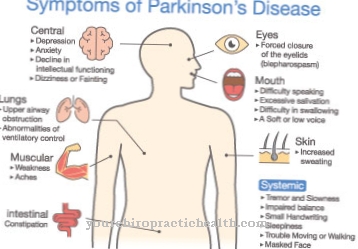The Tripartite Thumb Polysyndactyly Syndrome is characterized by a multiple linkage of the thumb, which is often associated with syndactylies and multiple linkages of the toes. The malformation syndrome arises on the basis of a genetic mutation and is inherited in an autosomal dominant manner, whereby the expressivity is subject to variability. The patients are treated by surgical amputation.
What is tripartite thumb polysyndactyly syndrome?

© bilderzwerg - stock.adobe.com
Polydactylia are diseases in which the patient suffers from multiple limbs of the fingers or toes. Such a multi-limb structure is also characteristic of the three-limbed thumb polysyndactyly syndrome. This complex of symptoms is an extremely rare birth defect that is sometimes classified as malformation syndromes.
The complex is also called tripartite thumb polysyndactyly syndrome postaxial polydactyly type 2. The malformation syndrome affects not only the hands but also the feet and is mainly characterized by a finger-like three-part thumb, which can be accompanied by an optional duplication of the thumb elements. The Holt-Oram syndrome has similar malformations and is associated with the tripartite thumb polysyndactyly syndrome as is Fanconi anemia.
The prevalence for the syndrome is reported to be approximately one case in 1,000,000 people. Familial clusters were observed in the cases documented so far. Science therefore assumes that the malformation complex is hereditary. The autosomal dominant inheritance with penetrance and variable expressivity is given as inheritance.
causes
The tripartite thumb polysyndactyly syndrome is genetic. A mutation is associated with the malformation syndrome.The disease is said to be based on mutations in the LMBR1 gene. This gene is located in the 7q36.3 gene locus and takes on the coding in the DNA for a protein with the name Limb region 1 protein homologous. It is not yet clear whether the protein is directly involved in limb development.
However, if the coding gene is mutated, the protein shows abnormal activity and thus presumably causes the symptoms of tripartite thumb polysyndactyly syndrome. The exact relationship between the genetic defect and its individual consequences has not been conclusively researched. It is also not yet known whether, in addition to genetic factors, external factors also contribute to the development of the syndrome.
If there is no familial accumulation of the syndrome in a family, a new mutation of the gene can probably still occur, which leads to a sporadic tripartite thumb polysyndactyly syndrome.
Symptoms, ailments & signs
Patients with tripartite thumb polysyndactyly syndrome have abnormalities in the hands and sometimes feet. You are affected by polydactyly, which manifests itself primarily in the area of the thumb. The patient's thumb is multi-limbed, especially three-limbed. The thumb function is usually retained. The multiple links of the thumb appear finger-like.
In some cases, there is syndactyly of the fingers or toes in addition to the multiple limbs. Such is always the case when the limbs of the hand or foot have grown together. Just as the poly- and syndactylies of the hand manifest themselves primarily on the thumb, they tend to manifest themselves on the patient's feet on the big toe.
In most patients, the changes in the foot are much less pronounced. For some they are barely visible and for others they are not present at all. Even within the same family, the degree of malformation can vary widely.
diagnosis
The diagnosis of tripartite thumb polysyndactyly syndrome is based on the clinical picture of the patient. Since there are no other malformations apart from the malformations mentioned, the differential diagnostic differentiation from other malformation syndromes is rather easy in the context of diagnostics.
There is a risk of confusion between the tripartite thumb polysyndactyly syndrome and the Holt-Oram syndrome. In case of doubt, the delimitation can be made by means of molecular genetic analysis. The prognosis for the patients is excellent. On the one hand, the malformations usually do not impair the function of the limbs of the hand and foot and, on the other hand, they can be corrected excellently in most cases.
Since there are no other malformations apart from the anomalies of the toes and fingers, the tripartite thumb polysyndactyly syndrome is one of the prognostically most favorable malformation syndromes.
Complications
The tripartite thumb polysyndactyly syndrome in most cases leads to severe anomalies and malformations of the feet and hands. The functions of the individual fingers and toes are usually preserved, although the syndrome can still restrict the patient's everyday life. In many cases, many activities are only possible to a limited extent or are associated with complications.
Especially in children, teasing and bullying can occur due to tripartite thumb polysyndactyly syndrome. Children then develop depression or other psychological complaints and suffer from a reduced quality of life. Not all patients are affected by changes in the hands and feet, so that these can only occur in one of the extremities.
There is usually no causal treatment for tripartite thumb polysyndactyly syndrome. For this reason, amputation of the respective limb is only possible if the patient so wishes. In many cases, the symptoms are not corrected unless they lead to restrictions in the patient's life.
However, most of those affected complain about the aesthetic aspects, which can lead to psychological complaints. The amputation does not lead to any further complications or complaints.
When should you go to the doctor?
If there is an accumulation of the syndrome in the family, an examination should be carried out during pregnancy. Expectant parents should contact the responsible doctor if there are relevant risk factors and make an appointment for an ultrasound examination.
The disease is usually diagnosed at the latest after the birth and can then be treated in a targeted manner. A doctor should be consulted for chronic pain and other complications. If an accident or fall occurs due to a misalignment, the emergency services must be called in any case.
A medical correction of the deformity is absolutely necessary. In addition, physiotherapeutic support may be recommended. As those affected often develop inferiority complexes and other psychological ailments later in life, a psychologist should be consulted. However, only the responsible doctor can answer the detailed measures to be taken. In addition to the family doctor, a specialist for malformations or a specialist for the respective symptom can be called in.
Doctors & therapists in your area
Treatment & Therapy
For patients with tripartite thumb polysyndactyly syndrome, there is no causal therapy available in the narrower sense, as the cause is a genetic mutation. The abnormalities are therefore not treated causally, but symptomatically. The treatment therefore depends heavily on the symptoms in the individual case. In most cases, the malformations are initially not corrected in the first time after the birth.
This is especially true in the case of additional syndactylies, which are more difficult to correct the smaller the hands and feet of the affected person. Since polydactyls do not impair the function of the hand or foot, surgical correction is not absolutely necessary from a medical point of view. Syndactylia can, however, impair function. Surgical separation procedures are available for correction, which are usually crowned with success from a certain age, especially in the case of membranous syndactylies.
Amputation of the multiple limbs in polydactyly can also make sense from a certain age, as the child concerned may encounter rejection or even discrimination at school at the latest. If this connection is true, serious psychological problems can arise in the course of life. Surgical amputation makes sense to avoid such a course.
Outlook & forecast
The tripartite thumb polysyndactyly syndrome does not self-heal. For this reason, patients are always dependent on treatment for the disease in order to permanently alleviate the symptoms.
If there is no treatment, various changes will occur on the patient's feet. The big toes are particularly affected, although in rare cases the thumbs on the fingers can also be affected. Difficulties arise in everyday life, which have a very negative effect on the patient's quality of life and limit everyday life. As a result, children can also suffer from bullying or teasing, which leads to psychological upset or even depression.
Treatment of tripartite thumb polysyndactyly syndrome is always carried out in the form of amputation. There are no further complications or complaints, and the symptoms are completely alleviated. The function of the hand or foot is also not negatively affected. The syndrome does not reduce the patient's life expectancy either. Early treatment in childhood can directly prevent possible psychological complaints or depression.
prevention
The tripartite thumb polysyndactyly syndrome cannot be prevented in the narrower sense, as it is a genetic disease. In the broadest sense, genetic counseling in the pregnancy planning phase can be described as a preventive measure.
Aftercare
With tripartite thumb polysyndactyly syndrome, the measures and options for follow-up care are very limited. Since it is a congenital and hereditary disease, complete or causal treatment is usually not possible. Those affected are therefore dependent on purely symptomatic treatment, with the primary focus being on early detection of the disease.
The earlier the tripartite thumb polysyndactyly syndrome is detected, the better the further course of this disease is usually. If the patient wants to have children, hereditary counseling can also be carried out. This may prevent the syndrome from being passed on to children. The treatment itself takes place through surgical interventions and various therapies.
In many cases, exercises from these therapies can also be performed in your own home, which speeds up healing. Bed rest must be observed in any case after the procedure. The person concerned should rest and take care of his body. Care and support from relatives and friends is also very important and can help accelerate healing. Whether the tripartite thumb polysyndactyly syndrome will reduce the life expectancy of those affected cannot be universally predicted.
You can do that yourself
Self-help opportunities for tripartite thumb polysyndactyly syndrome are limited. A change in physical conditions cannot be achieved with your own resources. In everyday life, the focus should be on dealing with the malformation.
Children who are born with the genetic disease should be informed as early as possible about the changes in their body compared to the physique of healthy people. An open approach to being different from normality helps the child in contact with fellow human beings and playmates of the same age. The child's self-confidence should be supported and promoted.
The child needs help with emotional or mental problems. In most cases, the assistance of family members or family members who are also sick is sufficient. Together they can practice the challenges of everyday life. The child is now prepared for the environment and learns to assert itself in unpleasant situations. At the same time, the visual changes should not be too much in the everyday focus of the events.
It is important to promote the strengths of the child and to discover the joy of life. With the tripartite thumb polysyndactyly syndrome, the child can live symptom-free. It is an optical flaw that does not impair or threaten life as a result.



.jpg)


.jpg)






.jpg)

.jpg)
.jpg)











.jpg)